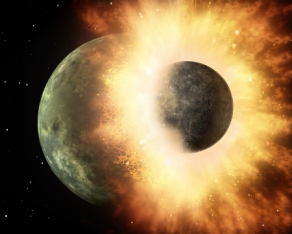
November Editorial
Moon Rocks and the 'Big Whack'

November Editorial
Moon Rocks and the 'Big Whack'
|
|
The 'Big Whack' was a literally Earth-shaking event that happened somewhere around 4.5 billion years ago, while the planet was still taking shape in the early solar system . At the same time, another Mars-sized planet was also taking shape, one which scientists today call 'Theia'. Since there is no Theia around today, you may wonder where this planet is. The answer is that it is around us and above us, because Theia ran into Earth in a head-on collision which scientists now believe created the Moon from the debris. Afterwards Theia ceased to exist, having become part of the Earth and Moon. The Big Whack theory answers two questions which have puzzled scientists for centuries. Why does the Earth only have one moon, and why is that moon so massive relative to the size of the Earth? Recently the 'whack' hypothesis was given further confirmation by studies of rocks which NASA brought back from the Moon in Apollo missions 12, 15 and 17. Edward Young, a cosmochemist and geochemist at the University of California, Los Angeles led the most recent of these studies, and his team's work has recently been released in the journal Science. Usually every moon and planet in the Solar System has a different ratio of oxygen isotopes in its rocks. Different isotopes have different numbers of neutrons, and the usual rule is that the larger the planetary body, the smaller the ratio of the oxygen17 isotope becomes relative to the other isotopes in an average rock. This is simply not true of the Earth and the Moon. Here, studies have shown that the oxygen17 ratios are virtually identical in Earth and Lunar rocks. This, despite the fact that the Moon is 2% of the Earth's volume and considerably less dense. Given this disparity, had the Moon formed independently of the Earth, the oxygen17 ratio in its rocks would have been vastly different. But because the ratio of oxygen17 isotopes is almost exactly the same Young and his team have argued that not only did the Big Whack take place, but the whack was even bigger than previously thought. Had Theia struck the Earth a glancing, or off-center blow, then the debris which later formed the Moon would have been mostly Theia, and the Moon rocks would mostly have Theia's isotope signature. However, Earth rocks and Moon rocks have identical signatures, which told Young and his team that the collision must have been a head-on impact which inextricably merged Theia and the Earth into a single mass of debris. More recent computer simulations have shown that this mass would have created a cloud some 500 times the volume of the Earth. Some matter fell back to the planet (which was probably spinning so fast that the days were only two hours long), and the rest accumulated to form the Moon. Originally the Moon was close to the Earth and had a high axial tilt. The tilt has become less and the distance greater. Nevertheless, that impact of 4.5 billion years ago continues to profoundly affect life on Earth. Journal Reference: |
| _______________________________ | ||||
| Home | | | Shopping | | | Database |
© Biscuit Software 2004-2015
All rights reserved